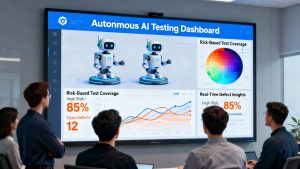Creating an intelligent, AI-powered knowledge base for internal teams is now more accessible and cost-effective than ever before. With the rise of innovative platforms and open-source tools, organizations can bypass expensive vendors and instead craft a tailored, scalable solution that puts them in complete control of their data and user experience. This approach not only accelerates deployment but also ensures the system is perfectly aligned with the team’s unique requirements.
A New Approach to Knowledge Management
Modern teams no longer need to rely on off-the-shelf knowledge base solutions that come with hefty price tags and limited customization. By leveraging tools like Cloudflare’s AutoRAG, Next.js, and a focused development effort, organizations can rapidly build robust, AI-powered knowledge repositories. This method empowers teams to iterate quickly, maintain data privacy, and deliver a truly personalized experience-all while keeping costs in check.
Integrating Diverse Data Sources
A comprehensive knowledge base thrives on the quality and breadth of its integrated sources. In this implementation, multiple streams of information are unified:
- Infrastructure Documentation: Structured insights from Terraform, generated via terraform-docs, provide clear, actionable infrastructure details.
- Internal Knowledge Systems: Content from platforms like Outline is seamlessly extracted and incorporated, ensuring that both technical and organizational knowledge is available at users’ fingertips.
Harnessing Cloudflare AutoRAG for Real-Time Intelligence
At the heart of the system lies the integration with Cloudflare’s AutoRAG API, operating in streaming mode. This setup offers several advantages:
- Instantaneous Response Generation: Users receive answers in real time, improving workflow efficiency.
- Scalable Knowledge Handling: The system can process vast amounts of documentation without performance bottlenecks.
- Contextual Awareness: Responses are tailored based on the specific context of the user’s query and the underlying documentation.
The API is accessed through a Next.js application, ensuring a seamless bridge between the knowledge base and its users.
Crafting an Engaging User Interface
User experience is paramount in encouraging adoption and maximizing the utility of the knowledge base. The frontend is meticulously designed with a “vibe coding” philosophy, focusing on both aesthetics and usability:
- Cohesive Visual Design: Consistent colors, typography, and spacing create a harmonious look and feel.
- Responsive Layouts: The interface adapts gracefully to all device sizes, maintaining usability and visual appeal.
- Interactive Features: Real-time response streaming, markdown support, and subtle animations make the experience both engaging and efficient.
- Thoughtful Error Handling: Users are guided with clear feedback and intuitive loading indicators, ensuring a frustration-free journey.
Modern Technical Architecture
The knowledge base is built on a robust, scalable tech stack:
- Frontend: Next.js with React, utilizing vibe-coded components for a polished UI.
- Backend: Node.js powers the core logic and integrations.
- Database: PostgreSQL ensures reliable and structured data storage.
- Containerization & Deployment: Docker, AWS ECR, and EKS provide a secure, scalable deployment pipeline.
Security and performance are prioritized through environment-based configurations, secure credential management, and efficient streaming implementations.
Key Benefits for Teams
- Rapid Knowledge Retrieval: Team members can instantly access relevant information without sifting through disparate sources.
- Contextual, Accurate Responses: AI delivers precise answers based on the full scope of integrated documentation.
- Real-Time Interaction: Streaming mode ensures users aren’t left waiting for insights.
- Scalable Architecture: Easily add new data sources or scale to support growing teams.
- Exceptional User Experience: The vibe-coded interface transforms knowledge retrieval into a pleasant, intuitive process.
Looking Ahead: Future Enhancements
The system is designed with extensibility in mind, paving the way for future improvements such as:
- Integrating additional documentation sources
- Enhancing response ranking and relevance algorithms
- Introducing advanced user interaction features
- Implementing analytics for usage tracking
- Further refining the user interface for even greater engagement
Conclusion: Setting a New Standard in Knowledge Management
This AI-driven knowledge base redefines what internal documentation can achieve. By merging advanced artificial intelligence with a beautifully crafted user experience, it transforms static information into dynamic, accessible knowledge. The result is more than just a tool-it’s a strategic asset that empowers teams, accelerates onboarding, and fosters a culture of continuous learning.
The architecture and design principles behind this solution ensure it will continue to evolve, setting a new benchmark for knowledge management in the digital workplace. As organizations seek to harness the full potential of their collective expertise, building an in-house, AI-powered knowledge base stands out as a forward-thinking, cost-effective strategy.
Read more such articles from our Newsletter here.



